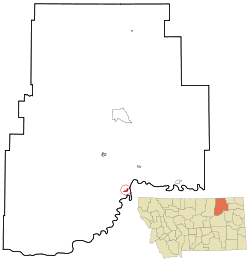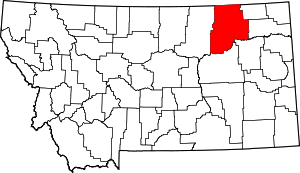Fort Peck, Montana
Fort Peck is a town in Valley County, Montana, United States. The population was 233 at the 2010 census.
Fort Peck, Montana | |
|---|---|
 Location of Fort Peck, Montana | |
| Coordinates: 48°0′28″N 106°27′1″W | |
| Country | United States |
| State | Montana |
| County | Valley |
| Area | |
| • Total | 0.89 sq mi (2.31 km2) |
| • Land | 0.89 sq mi (2.31 km2) |
| • Water | 0.00 sq mi (0.00 km2) |
| Population | |
| • Total | 233 |
| • Estimate (2019)[3] | 239 |
| • Density | 267.64/sq mi (103.30/km2) |
| Time zone | UTC-7 (Mountain (MST)) |
| • Summer (DST) | UTC-6 (MDT) |
| ZIP code | 59223 |
| Area code(s) | 406 |
| FIPS code | 30-28450 |
History
The name Fort Peck is associated with Col. Campbell K. Peck, the partner of Elias H. Durfee in the Leavenworth, Kansas, trading firm of Durfee and Peck. In 1867, company employee Abe Farwell constructed the Fort Peck trading post along the Missouri River, which enjoyed a virtual monopoly in trade with the Sioux and Assiniboine people. After its short life as a trading post, Fort Peck served as an Indian agency from 1873 until 1878. At that time, the agency was moved to its current location at Poplar. Fort Peck had a post office from 1879 to 1881.
A new town of Fort Peck, located about 2 miles north of the original, was built in 1934 to house Army Corps of Engineers employees involved in the construction of the Fort Peck Dam. Designed to be temporary, the government-owned town nevertheless included many features of a permanent town, including an administrative headquarters, a hospital, stores, a theater, a recreation hall, and other facilities. Totally inadequate to house the 10,000-plus employees, Fort Peck was soon joined by numerous shanty towns, including Wheeler, New Deal, Delano Heights, and Park Grove. The Fort Peck Original Houses Historic District, the Fort Peck Theatre, and the hospital, administration building, and other associated public works properties are listed in the National Register.[4]
The Administration Building,[5] the Employee's Hotel and Garage,[6] the Garage and Fire Station,[7] the Hospital,[8] and the Recreation Hall[9] of the government-run town are listed on the National Register of Historic Places.
Culture
The US Army Corps of Engineers, which oversees the powerhouses, dam, lake, and dredge cuts, is the major employer in Fort Peck, as well as, other government programs. Until recently all of the houses in Fort Peck were government built.
Fort Peck draws people from hundreds of miles away to recreate around Fort Peck Reservoir. Most popular is utilizing the lake and dredge cuts for boating, swimming, and fishing. Camping and barbecuing are very popular and facilities for camping and cooking are well developed. The Fort Peck Theater is open during the summer and draws large crowds.
Geography
Fort Peck is located at 48°0′28″N 106°27′1″W (48.007858, -106.450327).[10]
According to the United States Census Bureau, the town has a total area of 0.86 square miles (2.23 km2), all of it land.[11]
Demographics
| Historical population | |||
|---|---|---|---|
| Census | Pop. | %± | |
| 1990 | 325 | — | |
| 2000 | 240 | −26.2% | |
| 2010 | 233 | −2.9% | |
| Est. 2019 | 239 | [3] | 2.6% |
| U.S. Decennial Census[12][13] | |||
2010 census
As of the census[2] of 2010, there were 233 people, 99 households, and 73 families living in the town. The population density was 270.9 inhabitants per square mile (104.6/km2). There were 110 housing units at an average density of 127.9 per square mile (49.4/km2). The racial makeup of the town was 93.6% White, 3.0% Native American, 0.4% Asian, and 3.0% from two or more races.
There were 99 households, of which 22.2% had children under the age of 18 living with them, 68.7% were married couples living together, 2.0% had a female householder with no husband present, 3.0% had a male householder with no wife present, and 26.3% were non-families. 21.2% of all households were made up of individuals, and 9.1% had someone living alone who was 65 years of age or older. The average household size was 2.35 and the average family size was 2.74.
The median age in the town was 48.9 years. 18% of residents were under the age of 18; 4.4% were between the ages of 18 and 24; 19.4% were from 25 to 44; 39.9% were from 45 to 64; and 18.5% were 65 years of age or older. The gender makeup of the town was 52.8% male and 47.2% female.
2000 census
As of the census[14] of 2000, there were 240 people, 91 households, and 75 families living in the town. The population density was 274.9 people per square mile (106.5/km2). There were 99 housing units at an average density of 113.4 per square mile (43.9/km2). The racial makeup of the town was 96.25% White, 2.08% Native American, and 1.67% from two or more races.
There were 91 households, out of which 38.5% had children under the age of 18 living with them, 73.6% were married couples living together, 5.5% had a female householder with no husband present, and 16.5% were non-families. 14.3% of all households were made up of individuals, and 7.7% had someone living alone who was 65 years of age or older. The average household size was 2.64 and the average family size was 2.89.
In the town, the population was spread out, with 28.8% under the age of 18, 2.9% from 18 to 24, 21.7% from 25 to 44, 32.9% from 45 to 64, and 13.8% who were 65 years of age or older. The median age was 43 years. For every 100 females, there were 92.0 males. For every 100 females age 18 and over, there were 87.9 males.
The median income for a household in the town was $47,083, and the median income for a family was $50,938. Males had a median income of $32,500 versus $33,750 for females. The per capita income for the town was $17,943. None of the families and 0.8% of the population were living below the poverty line, including no under eighteens and 6.9% of those over 64.
Notable people
The notable people were born, raised, or lived here for a time.
- David Midthunder, Assiniboine-Sioux actor was born here. He grew up on the Fort Peck Reservation. (The Missing, Hidalgo and Into the West)
- Wayne Hawkins, Oakland Raiders guard, was born here.
- Ron Hauge, Emmy award-winning writer for The Simpsons grew up here, and went to high school in the neighboring city of Glasgow.
See also
References
- "2019 U.S. Gazetteer Files". United States Census Bureau. Retrieved July 26, 2020.
- "U.S. Census website". United States Census Bureau. Retrieved 2012-12-18.
- "Population and Housing Unit Estimates". United States Census Bureau. May 24, 2020. Retrieved May 27, 2020.
- Montana Placenames: From Alzada to Zortman, p. 92. Montana Placenames Companion Website
- Rebecca J. Otto (August 1985). "National Register of Historic Places Inventory/Nomination: Administration Building". National Park Service. Retrieved July 26, 2017. With photo from 1985.
- Rebecca J. Otto (August 1985). "National Register of Historic Places Inventory/Nomination: Employee's Hotel and Garage / Fort Peck Hotel". National Park Service. Retrieved July 26, 2017. With four photos from 1985.
- Rebecca J. Otto (August 1985). "National Register of Historic Places Inventory/Nomination: Garage and Fire Station / Security Center (Fire & Police) & Vehicle Storage". National Park Service. Retrieved July 26, 2017. With two photos from 1985.
- Rebecca J. Otto (August 1985). "National Register of Historic Places Inventory/Nomination: Hospital / Apartments". National Park Service. Retrieved July 26, 2017. With three photos from 1985.
- Rebecca J. Otto (August 1985). "National Register of Historic Places Inventory/Nomination: Recreation Hall". National Park Service. Retrieved July 26, 2017. With two photos from 1985.
- "US Gazetteer files: 2010, 2000, and 1990". United States Census Bureau. 2011-02-12. Retrieved 2011-04-23.
- "US Gazetteer files 2010". United States Census Bureau. Archived from the original on 2012-07-02. Retrieved 2012-12-18.
- "Census of Population and Housing". Census.gov. Retrieved June 4, 2015.
- "Census & Economic Information Center". Retrieved July 3, 2015.
- "U.S. Census website". United States Census Bureau. Retrieved 2008-01-31.
